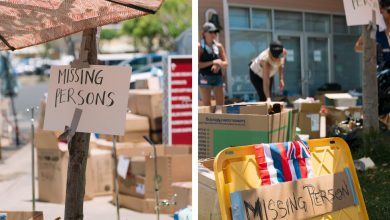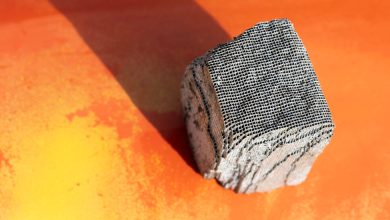The Thin Blue Line That Divides America

Among the banners that Donald Trump’s supporters carried as they stormed the Capitol three years ago — 2016’s Make America Great Again flags and 2020’s Keep America Great flags, Confederate battle flags, Gadsden flags, Pine Tree flags, the Stars and Stripes — appeared a now-familiar variant of the American flag: white stars on a black field, with alternating black and white stripes, except for the stripe immediately beneath the union, which is blue.
As a piece of design work, it is slightly awkward; the colored stripe attempts to impose symmetry on an image that is fundamentally asymmetric. But as a political totem it is undeniably powerful. A merger of the American flag with a symbol representing the police, the thin blue line flag has become a potent statement in its own right.
First introduced in the 2010s, it quickly became the dominant popular symbol of the police, flown in pride, solidarity, memoriam, defiance. It was something more than that, too. Beyond a marker of professional affiliation, it was a symbol of personal identity, one that was not restricted to members of law enforcement — one that could even, eventually, be used against them.
How a symbol of support for the police came to be borne by rioters as they smashed through a police line is a story that encompasses 70 years of rhetoric about policing, crime and politics in the creation of a new tribal identity — one that swept Mr. Trump into office and tried to keep him there. But it starts an ocean away, during the Crimean War, 169 years ago.
Allied Ottoman, British and French forces were trying to hold off a Russian attack on the small port city of Balaclava in 1854. The war correspondent William H. Russell observed the battle from an overlooking ridge, and his dispatch for The Times of London captured the scene with impressionistic immediacy — the Russian cavalry were “clouds of mounted skirmishers, whirling and wheeling in front of their march like autumn leaves tossed by the wind”; later, their advance was composed of “shifting trails of men, which played all over the valley like moonlight on the water.”
At what seemed a pivotal moment in the battle, the Russian cavalry advanced on the woefully outnumbered soldiers of the British 93rd Regiment standing between them and a base. Russell wrote that the scarlet-clad regiment — arranged in two lines rather than the usual four — looked like a “thin red streak topped with a line of steel.” The 93rd fired two volleys at the approaching Russian troops. At the second volley, the troops turned aside, the base was saved, and a legend was born.
A few months later, The Times reported that during a debate in the House of Lords about whose feats of valor should be honored with medals, the Earl of Ellenborough praised the heroism of “the ‘thin red line’ who had met and routed the Russian cavalry.” Ellenborough was almost certainly referring to Russell’s account, but whether his poetic rewording was an accidental paraphrase or an intentional gloss is history’s secret. Either way, it was this version of the phrase that took hold in the popular lexicon, and so completely that even Russell, years later, seems to have forgotten that the line had ever been a streak.
Almost as soon as the phrase was coined, its definition was broadened to become shorthand for the British military more generally, particularly its courage in the face of long odds or superior numbers. Color-swapped one-off riffs followed — the thin white line of British colonizers, the thin yellow line of conservative activists.
In the United States, Willis John Abbot, a military journalist, wrote of how, at the Battle of Vicksburg, “the Confederates were seen to fall into confusion, waver, and give way before a thin blue line” — the advance guard of the Union troops. Other writers deployed the concept to refer to the Roughriders at San Juan Heights and the American frontier garrisons that stretched across the West.
As old age thinned the ranks of the Civil War veterans, and drab olives and browns replaced the deep blue of the Army’s service uniforms, this “thin blue line” came to refer to a new group: police officers.
Almost a century after the Battle of Balaclava, William H. Parker, a career police officer and a World War II veteran who had been wounded in Normandy, became the head of the Los Angeles Police Department. Parker’s ascension in 1950 came with a mandate to root out corruption and rehabilitate the department’s battered image. And on the battlefields of Crimea, he found a metaphor to inform both tasks.
“Between the law-abiding elements of society and the criminals that prey upon them,” Parker said, “stands a thin blue line of defense — your police officer.” The police, in Parker’s vision, weren’t just protecting public safety; they were combating the decline of Western civilization, the rise of Communism, the moral laxity of postwar America, the decay of the nuclear family, and so on.
Parker remade the department in the professional, militaristic image of the thin blue line. (To help publicize this transformation, he also created a public access talk show by that name, along with effectively co-creating “Dragnet,” the ur-police procedural.) He withdrew his officers from community events and foot patrols, placing them instead in vehicles and insulating them from political oversight. These changes did reduce corruption, but they had another effect: They turned the L.A.P.D. into an occupying army.
The thin blue line would become the dominant metaphor for the police. In 1981, President Ronald Reagan said the thin blue line held back “a jungle which threatens to reclaim this clearing we call civilization”; in 1993, President Bill Clinton called it “nothing less than our buffer against chaos, against the worst impulses of this society.”
But Parker’s vision went beyond policing as a profession. In 1965, he told a civil rights commission investigating the Watts riots that “the police of this country, in my opinion, are the most downtrodden, oppressed, dislocated minority in America.” This belief, a half-century later, would animate an identity politics that blurred the blue line. For its adherents, being a police officer would not be necessary to be considered a soldier in the battle between order and chaos. Eventually, it would not even be sufficient. And in some cases it would even be disqualifying. This identity group would have a flag that would embody Parker’s favorite metaphor.
Since at least the 1980s, police officers had been adding a stripe of blue to the black mourning band they added to their badge to remember fallen colleagues. In the 1990s, Steve Bollinger, a police shooting instructor from DeKalb County, Ga., sold lapel pins and car decals that featured that blue stripe on a black field — but only to fellow officers (though enterprising civilians figured out that putting it on your bumper might help you avoid a speeding ticket). But in late 2014, Andrew Jacob, a University of Michigan student, saw the opportunity to market a different version of the symbol.
As the country was roiled by protests after decisions not to indict police officers for the deaths of Michael Brown and Eric Garner, as well as the shooting of Tamir Rice, Mr. Jacob sketched out a black and white American flag with one blue stripe running just below the stars. Weeks later, after two New York police officers were killed by a man vowing to avenge Mr. Brown and Mr. Garner, he began producing and selling that flag and helped to catalyze a movement.
Blue Lives Matter is not just an expression of support and solidarity for the police, but a response to and rejection of Black Lives Matter. It suggests that it is not Black people whose lives are undervalued by society, but police officers.
The innocuous-sounding slogan Black Lives Matter can represent a range of political narratives, from the modest request to reduce the number of people killed by police officers to the expansive argument that the criminal justice system — and virtually every American institution — is irredeemably racist and must be abolished.
Similarly, Blue Lives Matter is a movement that belies the simplicity of its name: It can certainly mean that the police deserve respect for doing a critical and dangerous job. But it can also mean that overzealous racial politics have inverted the criminal justice system, punishing the peacekeepers, coddling the criminals and turning those who carry a badge into the most embattled and victimized group in the nation. Blue Lives Matter transformed policing into a tribal affiliation.
This is why the thin blue line flag fit so comfortably alongside the other symbols borne by the coalition of the far right that gathered in Charlottesville, Va., for the deadly Unite the Right rally in 2017: the alt-right’s faux-ironic Nazi homage, the flag of Kekistan; an updated version of the cluttered mash-up of the Nazi Party and American flags that is the banner of the neo-Nazi National Socialist Movement; the teal and white Dragon’s Eye of the white nationalists of Identity Evropa; swastikas and Sonnenrads; Confederate battle flags. Mr. Jacob immediately denounced the use of the thin blue line flag’s use by white supremacists, but its symbolic potential had been demonstrated months earlier. When Representative Steve King was criticized for keeping a Confederate battle flag on his desk — he represented Iowa, a Union state with no Southern heritage — he quietly replaced it with a thin blue line flag.
The flag’s closest forebear is the now largely forgotten black and white American flag employed by Black Lives Matter protesters in the immediate wake of the killing of Mr. Brown in Ferguson, Mo. Functionally, it recalls the minimalist color swap of the artist David Hammons’s African American flag, which changes out the red, white and blue for the red, black and green of the pan-Africanist movement. With its minimalist palette, it powerfully evokes the desaturated American flag patches sometimes worn on military camouflage. As the L.G.B.T. American flag does, it exploits a visual pun, but much less playfully: The blue line divides America against itself.
Like other mash-ups of identity flags with the American flag, the thin blue line flag is a rallying point for a marginalized identity, a way to lay claim to the American birthright, a demand for long-denied respect. And you don’t have to be a police officer to wrap yourself in it.
This blossoming identity was an opportunity for any politician bold enough to take it. While trust in the police was dropping among Black and Hispanic Americans, it actually was rising for white Americans. Donald Trump was particularly well suited to take advantage of the rise of policing as identity politics. His entrance onto the political scene in the 1980s was his call for the reinstatement of the death penalty and less oversight of police. So it was not surprising that Mr. Trump’s run for the presidency was accompanied by calls for the police to be “tougher,” an expansion of stop and frisk, the death penalty for the killing of police officers, “extreme vetting” of refugees, a southern border wall, and a ban on immigration from particular countries with large Muslim populations.
At the Republican National Convention in 2016, after Mr. Trump had captured the nomination, David Clarke, the Black sheriff of Milwaukee County, stood before the crowd, wearing a thin blue line flag pin on his uniform, and railed against the “anarchy” of the Black Lives Matter movement and the “collapse of social order.”
By the time Mr. Trump’s 2020 re-election campaign rolled around, the Black Lives Matter movement was resurgent in the wake of the death of George Floyd, given fresh urgency by the Trump presidency and a harder edge by the dislocation caused by Covid. The Trump campaign cast the Democrats as enemies of law and order who sought to incubate riots in American cities and chaos at the border.
At a rally in Waukesha, Wis., the thin blue line flag took center stage, hanging above the crowd behind the lectern at which Mr. Trump spoke, in the position traditionally occupied by the American flag. In Macon, Ga., it hung vertically behind the stage in a diptych with the Stars and Stripes. At a rally in Bullhead City, Ariz., it festooned the bleachers flanking the podium, while an enormous version, held aloft by a crane, waved high above the crowd. From the stage, Mr. Trump claimed that while the Democratic ticket stood with “rioters and vandals,” he stood with “the heroes of law enforcement.”
At the Republican National Convention, Vice President Mike Pence laid out the consequences of Mr. Trump losing the election in stark, personal terms: “The hard truth is you will not be safe in Joe Biden’s America. Under President Trump, we will always stand with those who stand on the thin blue line.”
To defend Americans from the conspiracy to steal the election and destroy the country, Mr. Trump suggested that his supporters — the police, the military, bikers, construction workers — would confront his enemies in the streets, rhetorically deputizing his allies as a law unto themselves: “They’re peaceful people, and antifa and all — they’d better hope they stay that way.”
After Mr. Trump’s prophecy came true and the soft coup of representative democracy denied him a second term, when his supporters rallied for one last stand on the grassy field in front of the Capitol, it was inevitable that they would see themselves as bearing the mantle of law and order, a thin blue line smashing through a thin blue line.
In the aftermath of Jan. 6, when the nation saw that flag held aloft by the rioters who attacked the Metropolitan Police officer Michael Fanone (he says they literally beat him with it), the thin blue line flag has become increasingly controversial among police officers themselves. In 2023, the Los Angeles Police Department banned its public display on the job. In an email explaining his decision to his officers, Chief Michel Moore lamented that “extremist groups” had “hijacked” the flag.
But it wasn’t opportunistic interlopers who turned a blue stripe on a flag into something that divides America. The idea, from the beginning, was woven right into the fabric.
Ezekiel Kweku is a special projects editor in Times Opinion.
Source photograph by Morry Gash/Associated Press.
The Times is committed to publishing a diversity of letters to the editor. We’d like to hear what you think about this or any of our articles. Here are some tips. And here’s our email: [email protected].
Follow the New York Times Opinion section on Facebook, Instagram, TikTok, X and Threads.




